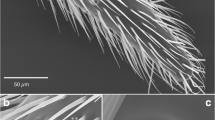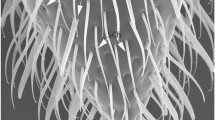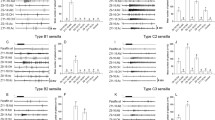Abstract
There are three morphological types of wall-pore single-walled sensilla on the antennae of Schedorhinotermes lamanianus workers. Among these, the sensilla of the type SW1 always bear two neurons that are distinguishable by their impulse amplitudes in electrophysiological recordings. Both neurons are odour-sensitive and respond with excitation to an equally narrow and strikingly congruent spectrum of odours. 1-Pentanol, 1-hexanol and 2-hexanol cause maximum excitation in both cells. In addition one cell responds to CO2. Short pulses of CO2 up to 3 s duration inhibit this cell totally. The duration of total inhibition increases with the logarithm of the CO2-concentration between 0.06% and 100%. Pulses of CO2 with concentrations above 0.15% cause an inhibition that lasts longer than the period of stimulation. Prolonged CO2 -stimuli (> 300 s) with a concentration between 0.5% and 5% CO2 initially cause total inhibition. However, after 1 to 5 min, activity reappears and reaches a new constant but dose-dependent frequency. None of the stimulatory odours leads to a response in the cell when applied together with CO2. The sensitivity to odours of this one cell type is “switched off” by CO2, whilst CO2 does not influence the other neuron in the same sensillum. The CO2-concentration, (high in the centres of termite nests, low outside the nests) may give important information about the context in which an individual receives a signal. The described modulation of odoursensitivity by CO2 allows the presentation of two hypothetical mechanisms of context-dependent signal interpretation.
Similar content being viewed by others
References
Abushama FT (1966) Electrophysiological investigations on the antennal olfactory receptors of the dampwood termite Zootermopsis angusticollis. Entomol Exp Appl 9: 343–48
Bogner F (1986) CO2-sensitive Rezeptoren der Labialpalpusgrube bei Schmetterlingen. Verh Dt Zool Ges 79: 200–201
Bogner F (1989) Antennale CO2-sensitive Rezeptoren bei TsetseFliegen. Verh Dt Zool Ges 82: 272–273
Bogner F (1990) Sensory physiological investigation of carbon dioxide receptors in Lepidoptera. J Insect Physiol 36: 951–957
Bogner F (1992) Response properties of CO2-sensitive receptors in tsetse flies (Diptera: Glossina palpalis). Physiol Entomol 17: 19–24
Bogner F, Boppré M, Ernst KD, Boeckh J (1986) CO2 sensitive receptors on labial palps of Rhodogastria moths (Lepidoptera: Arctiidae): physiology, fine structure and central projection. J Comp Physiol A 158: 741–749
Burkhardt JF (1991) Der Einfluß verschiedener CO2-Konzentrationen auf das Verhalten der Ameise Pheidole pallidula. Verh Dt Zool Ges 84: 303–304
Camhi JM (1983) Neuroethology. Nerve cells and the natural behavior of animals. Sinauer Associates Inc. Sunderland, Massachusetts
Cook SF (1932) The respiratory gas exchange in Termopsis nevadensis. Biol Bull 63: 246–257
Davis EE, Bowen MF (1994) Sensory physiological basis for attraction in mosquitoes. J Am Mosquito Control Assoc 10: 316–325
Den Otter CJ, Van der Goes van Naters WM (1992) Single cell recordings from tsetse (Glossina m. morsitans) antennae reveal olfactory, mechano- and cold receptors. Physiol Entomol 17: 33–42
Dickens JC, Billings RF, Payne TL (1992) Green leaf volatiles interrupt aggregation pheromone response in bark beetles infesting southern pines. Experientia 48: 523–524
Diesendorf M (1975) General anaesthetic excitation and inhibition of insect CO2-receptors: an interpretation. In: Denton DA, Coghlan JP (eds) Olfaction and taste V. pp 195–198
Floyd MA, Evans DA, Howse PE (1976) Electrophysiological and behavioural studies on naturally occurring repellents to Reticulitermes hucifugus. J Insect Physiol 22: 697–701
Grant AJ, O'Connell RJ (1986) Neurophysiological and morphological investigations of pheromone-sensitive sensilla on the antenna of male Trichoplusia ni. J Insect Physiol 32: 503–515
Grant AJ, Wigton BE, Aghajanian JG, O'Connell RJ (1995) Electrophysiological responses of receptor neurons in mosquito maxillary palp sensilla to carbon dioxide. J Comp Physiol A 177: 389–396
Holscher KH, Gearhart HL, Barker RW (1980) Electrophysiological responses of three tick species to carbon dioxide in the laboratory and field. Ann Entomol Soc Am 73: 288–292
Howse PE (1984) Sociochemicals of termites. In: Bell WJ, Cardé RT (eds) Chemical ecology of insects. Chapman and Hall, London pp 475–519
Kafka WA (1970) Molekulare Wechselwirkungen bei der Erregung einzelner Riechzellen. Z Vergl Physiol 70: 105–143
Kafka WA (1987) Similarity of reaction spectra and odor discrimination: single receptor cell recordings in Antheraea polyphemus (Saturniidae). J Comp Physiol A 161: 867–880
Kaib M (1990) Intra- and interspecific chemical signals in the termite Schedorhinotermes lamanianus-production sites, chemistry and behaviour. In: Gribakin FG, Wiese K, Popov AV (eds) Sensory systems and communication in arthropods. Advances in Life Sciences. Birkhäuser, Basel Boston Berlin, pp 26–32
Kaib M, Ziesmann J (1992) The labial gland in the termite Schedorhinotermes lamanianus (Isoptera: Rhinotermitidae): Morphology and function during communal food exploitation. Insectes Sociaux 39: 373–384
Kaib M, Ziesmann J, Wqlfrum U (1993) Modulation of odoursensitivity by carbon dioxide in a termite sensillum: a possible mechanism for signal interpretation. In: K Wiese et al. (eds) Sensory systems of arthropods. Birkhäuser, Basel, pp 481–488
Kellogg FE (1970) Water vapour and carbon dioxide receptors in Aedes aegypti. J Insect Physiol 16: 99–108
Lacher V (1964) Elektrophysiologische Untersuchungen an einzelnen Rezeptoren für Geruch, Kohlendioxid, Luftfeuchtigkeit und Temperatur auf den Antennen der Arbeitsbiene und der Drohne (Apis mellifera L.). Z. Vergl Physiol 48: 587–623
Masson C, Mustaparta H (1990) Chemical information processing in the olfactory system of insects. Physiol Rev 70: 199–245
Noirot C (1969): Glands and secretions. In: Krishna K, Weesner FM (eds) Biology of the termites. Vol. 1. Academic Press, New York London, pp 223–282
Paim U, Beckel WE (1963) Seasonal oxygen and carbon dioxide content of decaying wood as a component of the microenvironment of Orthosoma brunneum (Forster) (Coleoptera: Cerambycidae). Canad J Zool 41: 1133–1147
Peakin GJ, Josens G (1978) Respiration and energy flow. In: Brian MV (ed) Production ecology of ants and termites (International Biological Programme; 13). Cambridge University Press, Cambridge London New York Melbourne, pp 111–164
Ruelle JE (1964) L'architecture du nid de Macrotermes natalensis et son sens fonctionnel. In: Bouillon A (ed) Etudes sur les Termites africains. Masson, Paris, pp 327–363
Sass H (1978) Olfactory receptors on the antenna of Periplaneta: response constellations that encode food odors. J Comp Physiol 128: 227–233
Schoonhoven LM, Blaney WM, Simmonds MSJ (1992) Sensory coding of feeding deterrents in phytophagous insects. In: Bernays E (ed) Insect-plant interactions 4. CRC Press, Boca Raton Ann Arbor London Tokyo, pp 59–79
Seeley TD (1974) Atmospheric carbon dioxide regulation in honeybee (Apis mellifera) colonies. J Insect Physiol 20: 2301–2305
Stange G (1992) High resolution measurement of atmospheric carbon dioxide concentration changes by the labial palp organ of the moth Heliothis armigera (Lepidoptera: Noctuidae). J Comp Physiol A 171: 317–324
Stange G, Diesendorf M (1973) The response of the honeybee antennal CO2-receptors to N2O and Xe. J Comp Physiol 86: 139–158
Stange G, Kaissling KE (1995) The site of action of general anaesthetics in insect olfactory receptor neurons. Chem Senses 20: 421–432
Steullet P, Guerin PM (1992): Perception of breath components by the tropical bont tick, Amblyomma variegatum Fabricius (Ixodidae) I. CO2-excited and CO2-inhibited receptors. J Comp Physiol A 170: 665–676
Visser JH, Van Straaten S, Maarse H (1979) Isolation and identification of the volatiles in the foliage of potato, Solarium tuberosum, a host plant of the Colorado beetle, Leptinotarsa decemlineata. J Chem Ecol 5: 13–25
Wolfrum U, Kaib M (1988) Kastenspezifisches Verhalten der Termite Schedorhinotermes lamanianus und dessen Beziehung zu Unterschieden in Ultrastruktur, Häufigkeit und Topographie antennaler Sensillen. Mitt Dtsch Ges Allg Angew Entomol 6: 86–90
Yamana K, Toh Y (1987) Intracellular recording from receptor cells of the temporal organ of the Japanese house centipede, Thereuonema hilgendorfii: receptor potential and conductance changes. J Exp Biol 131: 205–213
Yamana K, Toh Y, Tateda H (1986) Electrophysiological studies on the temporal organ of the Japanese house centipede, Thereuonema hilgendorfii. J Exp Biol 126: 297–314
Ziesmann J, Kaib M (1991) Spurorientierung der Termite Schedorhinotermes: Einfluß der Pheromonkonzentration auf Lokomotion und Antennenbewegung. Verh Dt Zool Ges 84: 372
Ziesmann J, Kaib M, Wolfrum U (1992) CO2-dependent response of an olfactory sensillum in the termite Schedorhinotermes lamanianus. Chem Senses 17: 894
Zimmermann PR, Darlington JPEC (1987) Methane and other metabolic gases produced by termites. In: Eder J, Rembold H (eds) Chemistry and biology of social insects. J Peperny, München, p 637
Author information
Authors and Affiliations
Rights and permissions
About this article
Cite this article
Ziesmann, J. The physiology of an olfactory sensillum of the termite Schedorhinotermes lamanianus: carbon dioxide as a modulator of olfactory sensitivity. J Comp Physiol A 179, 123–133 (1996). https://doi.org/10.1007/BF00193440
Accepted:
Issue Date:
DOI: https://doi.org/10.1007/BF00193440




